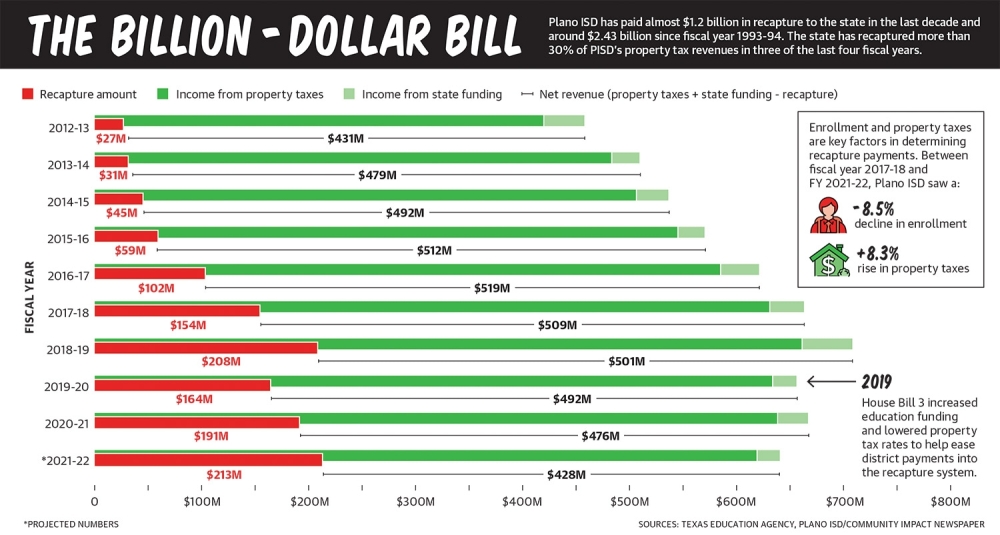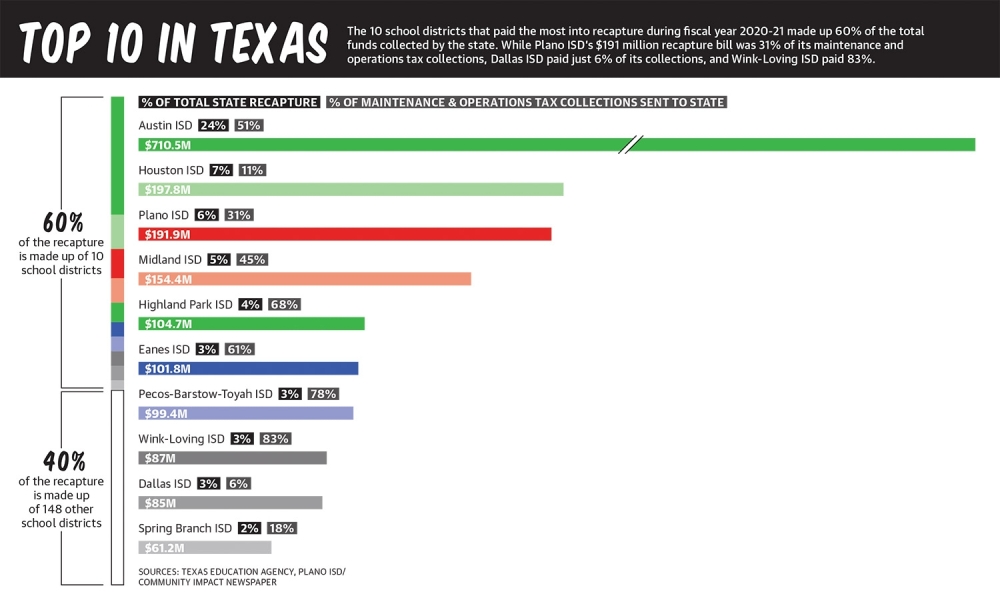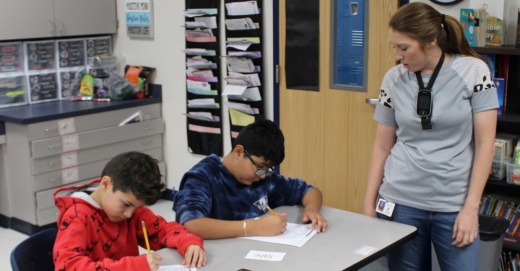Chief Financial Officer Johnny Hill anticipates PISD will pay nearly $218 million to the state in mid-2023. This year’s payment of almost $213 million is projected to give the district the second largest recapture bill in the state, behind only Austin ISD. Hill said PISD could remain second in the state next year, depending on what Houston ISD has to pay.
Recapture redistributes property tax dollars from property-wealthy districts to those deemed property-poor by the Texas Education Agency.
“PISD has been planning for this day for a long time,” PISD Board President David Stolle said of the rising bill. “We are now at the point where [very soon] we are going to have to stop delivering the programs that we currently deliver because we can’t infinitely fund a deficit budget.”
For this school year, the PISD board approved a budget that had $19.6 million more in expenses than in revenue. The district tapped its fund balance to cover the difference. The decline in PISD’s student enrollment over the last several years combined with rising property tax revenues due to Plano’s strong housing market have been the main drivers for the district’s increasing recapture payments, Hill said.
As PISD has had to do for the last several years, Hill said he anticipates another deficit budget will be put in place for fiscal year 2022-23.
“There’s no inflationary factor built into our budget, so ... all of that additional tax collection is simply being collected by the district and being sent on to the state,” he said. “That’s why our deficits [are] going up and up and up.”

Calculating recapture
Of the more than 1,000 public school districts in the state, around 160 of them paid into recapture during fiscal year 2020-21, according to the Texas School Coalition. That group is made up of school districts that advocate for sustainable state education funding, the coalition’s Executive Director Christy Rome said.
The coalition estimates the state collected nearly $3 billion in recapture from school districts last year. Since Texas began the recapture program in 1994, PISD officials said their district has sent more than $2.43 billion to the state.
“Texas education code makes provisions for certain school districts to share their excess local tax revenue with other school districts,” said Amy Copeland, TEA’s director of state funding, in a video on recapture shared on the agency’s YouTube page. “Excess local revenue is local revenue that exceeds a school district’s formula entitlement.”
Hill explained that entitlement is based on factors related to the district’s enrollment—including student characteristics, special needs and more—as well as district characteristics, including size and property taxes.
“If you actually [collect] more [property tax] money than what you’re entitled to, that excess revenue goes back to the state,” Hill said.
As part of the TEA video, Copeland explained those excess funds “are recaptured by the school finance system to assist with the financing of public education” in Texas.
The TEA video showed that it took a decade for the recapture program to collect more than $1 billion annually. Another 14 years then passed before it surpassed the $2 billion threshold in 2018.
However, due to rising property values, state collections were projected to jump to nearly $5 billion by 2023, Copeland said.
To help slow that rise, the Texas Legislature passed House Bill 3 in 2019. As part of the bill’s school finance reforms, recapture’s collections were projected to be reduced by more than 50%, according to the TEA video.
“[House Bill 3] did make recapture a whole lot better than how horribly bad it could have been,” Rome said.
However, she said recapture has since vaulted back above its previous record high.

Following the money
One of the biggest misconceptions about recapture, according to Hill, is that the funds collected by the state benefit schools with lower property wealth levels.
“This is just a flat out lie,” he said. “It doesn’t matter [where they are] on the wealth level. [School districts are] entitled to a certain amount of money based on [Texas education code]. That doesn’t change.”
PISD Board Vice President Nancy Humphrey said even though the district is classified as “property wealthy,” not all of its residents are wealthy. District officials said 35% of PISD’s students are classified as economically disadvantaged, and 19% are English language learners.
Humphrey said recapture has become another revenue source for the state. More than 30% of PISD’s property taxes over the last two years were recaptured by the state as excess revenue.
“The individual taxpayer has no clue they’re being fleeced like this,” Humphrey said. “There’s no transparency in where that money goes.”
The Texas School Coalition believes the recapture system benefits the state budget more than it does school districts, Rome said. Over the last two years, the state collected $1.4 billion more from recapture than it needed to cover education expenses, she said.
“It was a $1.4 billion savings for the state, which allowed them to spend state funds elsewhere in the state budget,” Rome said.
Once funds are transferred to the state’s general fund, it becomes nearly impossible to trace how it is used, she said.
“The state budget is somewhat of a black hole,” Rome said.

What can be done
While PISD could reduce its recapture bill slightly for fiscal year 2022-23 by reducing its property tax rate, Hill explained that would also mean losing out on additional funding from the state.
“We give up about $3 million [from the state] for every $0.01 we reduce [the property tax rate],” Hill said. “[As] our deficits are growing, we don’t think we can do that.”
Meaningful change to the recapture system has long been a top legislative priority for PISD, Stolle said, and it will continue to be until something is done.
Among the changes PISD is advocating for are limits to recapture relative to a district’s total revenue. PISD officials also want to see districts refunded payments that are not used on education. District officials also said the state should create collection formulas that reflect inflation and differences in cost of living between rural and urban areas.
“If you look at the percentage of recaptured dollars that went into the [state’s] general fund and extrapolate down to PISD—if the state gave us that back, we wouldn’t have a deficit,” Stolle said.
Rome said the Texas School Coalition put together the website www.recapturetexas.org as a resource for taxpayers to learn more about where their money is going.
“Our hope is that they will take the information that they’ve learned there and from other resources and talk with state leaders,” she said. “Write those letters, and make those phone calls [to say], ‘This is something that I care about.’”
In PISD, Stolle estimated the district likely has enough money in its accounts to cover one more budget cycle before recapture forces cuts to current school programs.
“It’s like paying for your living expenses out of your savings account—you can only do that so long before you have to cut out something from your budget,” Stolle said. “We’ve so far been able to continue offering the programming that we want to offer, but that’s the cliff we see coming up very rapidly.”





